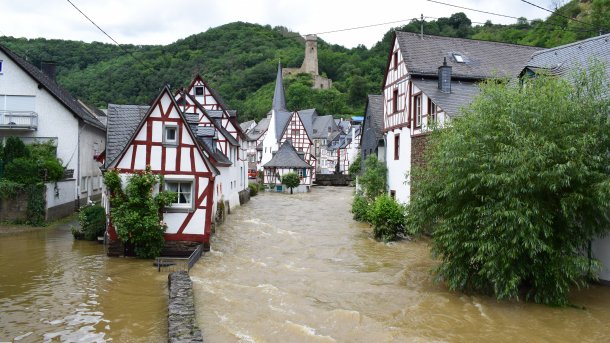Distribute money for climate protection fairly - try it out via webapp
To help poorer countries reduce emissions, money must be better distributed. With an online tool, anyone can try their hand at it.

Monreal in the Eifel in July 2021
(Bild: M. Volk/Shutterstock.com)
(Hier finden Sie die deutsche Version des Beitrags)
If the financing of global climate protection is to be fair, between $248 billion and $1582 billion would have to flow into poor countries, primarily from North America and Europe. The minimum or maximum amount can now be calculated using an application published online by the International Institute for Applied Systems Analysis (IIASA) in Laxenburg near Vienna. Depending on the political weighting of different criteria for equity, more or less money can be allocated to reducing emissions and protecting against climate impacts.
Unsurprisingly, what this makes clear: The annual 100 billion US dollars by 2020 for climate protection projects in poor countries would not have made much difference. But the donor countries have broken the promise they made at the 2009 Climate Change Conference in Copenhagen. Just 83 billion were collected in the final year 2020. Thanks to creative accounting, however, this was only a purely arithmetical figure, because the donor countries were allowed to decide for themselves how they wanted to balance their accounts. Some included development aid, loans or even export subsidies in their calculations. Oxfam estimates that only about one-third of this amount was available for climate protection and adaptation in poor countries.
Climate justice funding
On the other hand, in 2019 and 2020, around 630 billion U.S. dollars a year would flow into climate financing worldwide, but 90 percent of this would go exclusively to technologies such as heat and power conversion, wind power, photovoltaics or CO₂ capture and storage. Only ten percent would be left over for protective measures.
When people talk about climate justice, they often mean only the fair distribution of the remaining CO2 budget of currently 280 billion tons until the 1.5-degree limit or 1.03 trillion tons until the 2-degree limit. There are a number of interactive web apps that illustrate such distributions, including the Climate Action Tracker, the Climate Equity Reference, and the Indian Climate Equity Monitor.
But in the meantime, it's no longer just a question of who is allowed to emit how many greenhouse gases or how much they have to cut back. It's about money. The Intergovernmental Panel on Climate Change (IPCC) already emphasized in the third part of its current report that funding for climate protection would have to increase by a factor of three to six in order to meet the annual requirement for global climate investments by 2030.
There is no shortage of sufficient capital and liquidity worldwide. According to estimates by the International Energy Agency (IEA), energy investments will rise to 2.4 trillion U.S. dollars this year, although one third of this will be for fossil energies. In addition, the oil and natural gas industry is even planning to spend around another one trillion U.S. dollars on the exploration of new sources by 2030.
Webapp presents financial flows
Shonali Pachauri from IIASA and her colleagues from Germany, Switzerland, England and the USA published a study on how this enormous capital could be redistributed in the short term and in a fair manner. The new online tool is based on this study.
The paper describes a way in which climate policymakers and negotiators could move closer to consensus by incorporating financial equity principles into what have been standard cost-effective mitigation scenarios during negotiations.
The webapp can be used to systematically explore fair contributions to near-term, regional investment needs for climate action through 2030, and to vividly illustrate sizes and directions of the necessary financial flows.
For this purpose, the scientists provide a selection of different characteristics, each of which reflects certain justice considerations that can be adjusted depending on the political or moral views of potential negotiating partners. The authors derived these indicators from global climate protection pathways, which are listed in the third part of the current IPCC report.
Criteria: Responsibility, ability and need
The web application only requires different variations in three metrics, namely measures of "responsibility", "capability" and "need".
The criterion of "responsibility" actually reduces to the catchphrase "polluter pays". The higher the cumulative CO2 emissions in the past, the more responsibility a polluter bears for slowing down climate change and dampening its effects. For this purpose, the developers only take into account carbon dioxide emissions since 1850 and since 1990, because politically it is disputed from which year the accumulations should be calculated. For the old industrialized countries, the cut-off year 1990 is more favorable, because from then on the emerging economies, including China, also contribute significantly to emissions.
One indicator of "performance" is per capita gross domestic product, but another is a wealth indicator that quantifies an economy's tangible assets and infrastructure.
However, the criteria "responsibility" and "performance" are closely related, which should be taken into account when making settings in the webapp. After all, today's prosperity in rich countries, "performance", is based primarily on past emissions, the criterion for "responsibility".
Finally, a country's "need" can be set, on the one hand, as the degree of deprivation in access to a Decent Living Standard (DLS). On the other hand, the focus can also be on the climate risk for a population.
Finally, an upper or lower limit can be set for the investment requirement, depending on the financial burden that citizens are expected to shoulder for climate financing, measured in terms of gross domestic product. But no matter which combination is selected in the web tool: In any case, international climate finance flows will have to be increased substantially.
(jle)